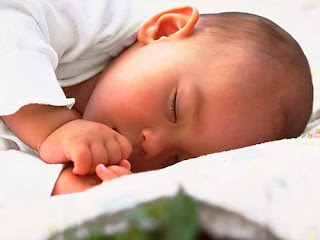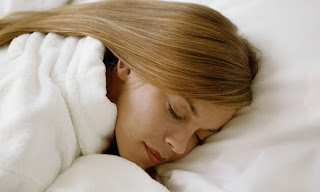Research Update: Infant Insomnia Prevention
by Gerrard Mackenzie
“Insomnia among infants?” Yes you are reading it right. Infants have their own version of insomnia. Latest research says that this is more likely experienced by infants born to mothers who are suffering from depression.
 The University of Michigan did a study which says that the first six months of life is crucial in establishing circadian rhythms - normal sleep and wake pattern. This factor is vital in the development of healthy sleep hygiene among children they grow up.
The University of Michigan did a study which says that the first six months of life is crucial in establishing circadian rhythms - normal sleep and wake pattern. This factor is vital in the development of healthy sleep hygiene among children they grow up.
Being an important stage, this is also a perfect time when prevention measures can be implemented. This is the reason why a mother has to understand and give priority not only to nutrition and other developmental milestones, but also in the establishment of normal sleep patterns and the implementation of ways to ensure that the baby gets adequate amounts of sleep.
The research showed how neglect of this particular aspect affects not just the mother but also the baby. The incidence is found to be higher among mothers who experience mood changes during and after pregnancy. Denial and ambivalence are normally experienced at the onset of pregnancy age. Post partum blues, a mild and temporary form of depression is also experienced by some after giving birth. However, some mothers unavoidably experience extreme depression during pregnancy and after delivery (intrapartum and postpartum depression.)
The cause is not yet clearly understood. However, some studies strongly link postpartum depression to endocrine factors. Regardless of whether the hormones are the culprit or not, the gravity of its effects on the mother and on the baby is undeniably serious.
The mother with post partum depression may experience a wide array of symptoms (severe mood swings, intense irritability and anger, loss of appetite, difficulty bonding with the baby, withdrawal from family and friends, etc.) Furthermore, insomnia here can be one of the causes and it can possibly be a result.
When all these things happen to a mother, indeed, the quality of care given to their babies suffers. There are some who are not capable of taking care of the baby while some even develop a tendency to harm the baby.
According to the University of Michigan (UM) research team, babies born to depressed moms are “prone to having chaotic sleep patterns in the first half-year” as compared babies born to non-depressed moms. Chaotic sleep patterns are manifested among infants who are sleeping more during the day, taking longer time before they can be put to sleep at night, with more frequent waking episodes, which is somehow similar to adults. This also predisposes them to depression as they grow up.
The leader of the UM Sleep Lab, Dr. Roseanne Armitage said that, “this doesn't mean that babies born to depressed moms are doomed to follow in their mothers' shoes, even though depression does tend to run in families.” Likewise she also added that this also does not mean that moms without history of depression should not pay attention to their babies sleep hygiene. It all boils down to one thing - all parents (with or without history of depression) must give importance to the sleep hygiene as early as the infancy period.
 In general, infants need a lot more hours of sleep than the grown ups. In the first 2 months, infants need 11 to 18 hours of sleep. In the next 10 months, they need 11 to 15 hours, on the average. However, infants get those hours of sleep in shorter chunks of time throughout the day.
In general, infants need a lot more hours of sleep than the grown ups. In the first 2 months, infants need 11 to 18 hours of sleep. In the next 10 months, they need 11 to 15 hours, on the average. However, infants get those hours of sleep in shorter chunks of time throughout the day.
Establishing an ideal sleep pattern among babies is quite a new idea for some but parents can implement this in various ways.
Parents can put on day clothes for daytime sleep and change into night clothes to help babies develop normal circadian rhythms, because babies can feel this. It would also help if parents make sure that their babies are exposed to adequate amounts of light during daytime so they can learn to distinguish daytime from nighttime sleep.
There are a lot more rituals that can be done to help strengthen the circadian rhythm of infants, but what we are working on is training the baby’s brain to sleep when it’s dark and be awake when there’s light or when it’s bright. Parents should also remember that the key to ensuring normal sleep among their babies is good parenting. You cannot just leave the infants on bed and expect that they automatically sleep.
Gerrard Mackenzie has taught thousands of the stressed-out, tired and overworked how to overcome their sleeping difficulties at http://www.superchargeyoursleep.com/
Article Source: Research Update: Infant Insomnia Prevention
by Gerrard Mackenzie
“Insomnia among infants?” Yes you are reading it right. Infants have their own version of insomnia. Latest research says that this is more likely experienced by infants born to mothers who are suffering from depression.
 The University of Michigan did a study which says that the first six months of life is crucial in establishing circadian rhythms - normal sleep and wake pattern. This factor is vital in the development of healthy sleep hygiene among children they grow up.
The University of Michigan did a study which says that the first six months of life is crucial in establishing circadian rhythms - normal sleep and wake pattern. This factor is vital in the development of healthy sleep hygiene among children they grow up.Being an important stage, this is also a perfect time when prevention measures can be implemented. This is the reason why a mother has to understand and give priority not only to nutrition and other developmental milestones, but also in the establishment of normal sleep patterns and the implementation of ways to ensure that the baby gets adequate amounts of sleep.
The research showed how neglect of this particular aspect affects not just the mother but also the baby. The incidence is found to be higher among mothers who experience mood changes during and after pregnancy. Denial and ambivalence are normally experienced at the onset of pregnancy age. Post partum blues, a mild and temporary form of depression is also experienced by some after giving birth. However, some mothers unavoidably experience extreme depression during pregnancy and after delivery (intrapartum and postpartum depression.)
The cause is not yet clearly understood. However, some studies strongly link postpartum depression to endocrine factors. Regardless of whether the hormones are the culprit or not, the gravity of its effects on the mother and on the baby is undeniably serious.
The mother with post partum depression may experience a wide array of symptoms (severe mood swings, intense irritability and anger, loss of appetite, difficulty bonding with the baby, withdrawal from family and friends, etc.) Furthermore, insomnia here can be one of the causes and it can possibly be a result.
When all these things happen to a mother, indeed, the quality of care given to their babies suffers. There are some who are not capable of taking care of the baby while some even develop a tendency to harm the baby.
According to the University of Michigan (UM) research team, babies born to depressed moms are “prone to having chaotic sleep patterns in the first half-year” as compared babies born to non-depressed moms. Chaotic sleep patterns are manifested among infants who are sleeping more during the day, taking longer time before they can be put to sleep at night, with more frequent waking episodes, which is somehow similar to adults. This also predisposes them to depression as they grow up.
The leader of the UM Sleep Lab, Dr. Roseanne Armitage said that, “this doesn't mean that babies born to depressed moms are doomed to follow in their mothers' shoes, even though depression does tend to run in families.” Likewise she also added that this also does not mean that moms without history of depression should not pay attention to their babies sleep hygiene. It all boils down to one thing - all parents (with or without history of depression) must give importance to the sleep hygiene as early as the infancy period.
 In general, infants need a lot more hours of sleep than the grown ups. In the first 2 months, infants need 11 to 18 hours of sleep. In the next 10 months, they need 11 to 15 hours, on the average. However, infants get those hours of sleep in shorter chunks of time throughout the day.
In general, infants need a lot more hours of sleep than the grown ups. In the first 2 months, infants need 11 to 18 hours of sleep. In the next 10 months, they need 11 to 15 hours, on the average. However, infants get those hours of sleep in shorter chunks of time throughout the day.Establishing an ideal sleep pattern among babies is quite a new idea for some but parents can implement this in various ways.
Parents can put on day clothes for daytime sleep and change into night clothes to help babies develop normal circadian rhythms, because babies can feel this. It would also help if parents make sure that their babies are exposed to adequate amounts of light during daytime so they can learn to distinguish daytime from nighttime sleep.
There are a lot more rituals that can be done to help strengthen the circadian rhythm of infants, but what we are working on is training the baby’s brain to sleep when it’s dark and be awake when there’s light or when it’s bright. Parents should also remember that the key to ensuring normal sleep among their babies is good parenting. You cannot just leave the infants on bed and expect that they automatically sleep.
Gerrard Mackenzie has taught thousands of the stressed-out, tired and overworked how to overcome their sleeping difficulties at http://www.superchargeyoursleep.com/
Article Source: Research Update: Infant Insomnia Prevention




















